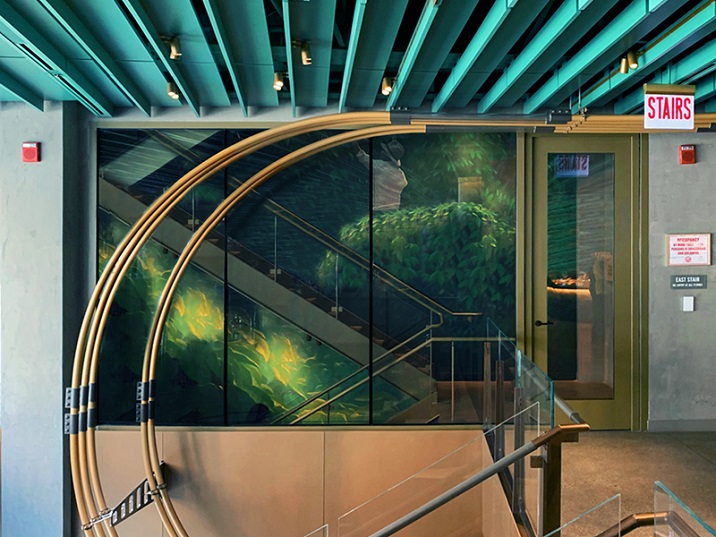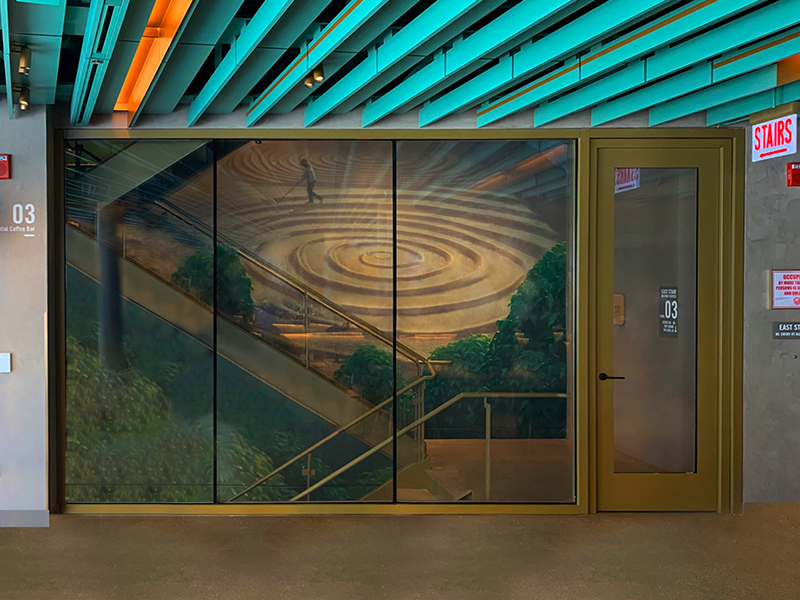The Starbucks Reserve Roastery in Chicago’s Magnificent Mile first opened in November 2019, marking it as the sixth Starbucks roastery globally and the third in the United States. Standing five stories tall, the 35,000 square foot facility is the world’s largest Starbucks. The roastery offers an immersive experience where patrons can ride spiral escalators surrounding a 56-foot cask for 360° views, catch master roasters and baristas impart their vast knowledge on the artistry and science of coffee, and ponder at an incredible, 4-story mural by Chicago artist Eulojio Ortega.
Ortega’s artwork is a progressive piece that pays homage to farmers and coffee-growing regions, exhibiting the art and life of coffee planting, selecting and processing. The mural, brilliant for conveying the story as visitors go from floor to floor, is interestingly located in an exit stairwell.
Traditionally, stairwells are enclosed in opaque walls, leaving them dark, isolated, and rarely utilized unless in an emergency. This is where the architects masterfully blended their creativity with their knowledge of advanced building material technology. To allow the mural to be visible through multiple floors, encourage stair usage and meet fire rated code requirements, the architects redesigned the 2-hour stairwell using transparent, floor-to-ceiling butt-glazed glass walls with the largest tested and listed fire resistive glass panels available.
To meet all the design and code requirements, the architects selected fire resistive, ASTM E-119 rated SuperLite II-XLB 120 by SAFTI FIRST® with Starphire Ultra-Clear glass for its superior optical clarity, large panel sizes and butt-glazing capabilities, which eliminated the need for obstructive vertical mullions for maximum transparency. With the largest individual glass panels over 10’ tall and over 4’ wide, this was easily accommodated by SuperLite II-XLB’s tested and listed size, which is the largest in the industry (133” maximum clear view height or width; 7,980 sq. in. maximum clear view area). As standard glass tends to have a slight blue-green tint from the iron induced from the glass manufacturing process, low-iron Starphire Ultra-Clear glass was used for its superior clarity, improved color neutrality and high visible light transmission – all of which are integral to highlighting the vibrance of Ortega’s artwork and transforming what would have been an ordinary stairwell into a significant element to this Starbucks’s immersive experience.

Each floor of this exit stairwell tells a story about coffee-growing, which is on full display thanks to the floor-to-ceiling expanses and butt-glazing capabilities of SuperLite II-XLB 120 with Starphire Ultra-Clear glass for superior clarity.
To ensure transparency and consistent high clarity with the accompanying entrance system, SAFTI FIRST’s GPX® Builders Series Temperature Rise Door was supplied with fire resistive, ASTM E-119 rated SuperLite II-XL 90 with Starphire Ultra-Clear glass in the door vision panel. This allowed architects to exceed the 100 sq. in. door vision panel code limitation that applies to fire protective glazing like ceramics used as vision panels in 60-90 minute temperature rise doors. The GPX Builders Series Temperature Rise Door and surrounding GPX® Architectural Series Perimeter Framing were supplied in a custom finish to blend seamlessly with Starbucks’s bronze palette.
The outcome is a clear, code-compliant stairwell that flaunts Ortega’s masterpiece and transforms ordinary stair-climbing into a truly one-of-a kind Starbucks experience.
Project Name: Starbucks Reserve Roastery in Chicago, IL
Architect: Perkins + Will
General Contractor: Pepper Construction
Glazing Contractor: SG Metal & Glass
Products: SuperLite® II-XLB 120 with Starphire Ultra-Clear® glass in GPX® Architectural Series Perimeter Framing and SuperLite II-XL® 90 with Starphire Ultra-Clear® glass in GPX® Builders Series Temperature Rise Doors
SAFTI FIRST, SuperLite and GPX are registered trademarks owned by SAFTI FIRST.
Starphire Ultra-Clear is a registered trademark owned by Vitro.
Related Stories
| Sep 13, 2010
Committed to the Core
How a forward-looking city government, a growth-minded university, a developer with vision, and a determined Building Team are breathing life into downtown Phoenix.
| Aug 11, 2010
New data shows low construction prices may soon be coming to an end
New federal data released recently shows sharp increases in the prices of key construction materials like diesel, copper and brass mill shapes likely foreshadow future increases in construction costs, the Associated General Contractors of America said. The new November producer price index (PPI) report from the Bureau of Labor Statistics provide the strongest indication yet that construction prices are heading up, the association noted.
| Aug 11, 2010
Using physical mockups to identify curtain wall design flaws
Part two of a five-part series on diagnosing and avoiding cladding, glazing, and roofing failures from building forensics expert IBA Consultants.
| Aug 11, 2010
Best AEC Firms of 2011/12
Later this year, we will launch Best AEC Firms 2012. We’re looking for firms that create truly positive workplaces for their AEC professionals and support staff. Keep an eye on this page for entry information. +
| Aug 11, 2010
AAMA leads development of BIM standard for fenestration products
The American Architectural Manufacturers Association’s newly formed BIM Task Group met during the AAMA National Fall Conference to discuss the need for an BIM standard for nonresidential fenestration products.
| Aug 11, 2010
NoricF4 custom metal ICF frames receive fire ratings, comply with antiterrorism standards for buildings
Reward Wall Systems' NoricF4 Custom Metal ICF Frames have received fire ratings of 1.5 hours to 3 hours and they have been evaluated to be in compliance with the prescriptive requirements of the Department of Defense Minimum Antiterrorism Standards for Buildings for blast/force protection.
| Aug 11, 2010
AIA Course: Enclosure strategies for better buildings
Sustainability and energy efficiency depend not only on the overall design but also on the building's enclosure system. Whether it's via better air-infiltration control, thermal insulation, and moisture control, or more advanced strategies such as active façades with automated shading and venting or novel enclosure types such as double walls, Building Teams are delivering more efficient, better performing, and healthier building enclosures.
| Aug 11, 2010
Glass Wall Systems Open Up Closed Spaces
Sectioning off large open spaces without making everything feel closed off was the challenge faced by two very different projects—one an upscale food market in Napa Valley, the other a corporate office in Southern California. Movable glass wall systems proved to be the solution in both projects.









